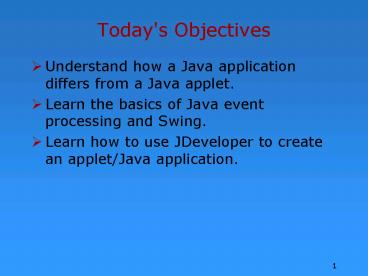Today's Objectives - PowerPoint PPT Presentation
1 / 18
Title:
Today's Objectives
Description:
Learn the basics of Java event processing and Swing. ... 'display button' to the form and bind the button to the appropriate event handler. ... – PowerPoint PPT presentation
Number of Views:52
Avg rating:3.0/5.0
Title: Today's Objectives
1
Today's Objectives
- Understand how a Java application differs from a
Java applet. - Learn the basics of Java event processing and
Swing. - Learn how to use JDeveloper to create an
applet/Java application.
2
Applet
- Applets display AWT objects in an Applet. Applet
is a subclass of the Container class. - Applets execute within an Internet Browser or
Appletviewer. - An applet tag is used to embed a reference to the
applet in a .html file e.g. myPage.html.
3
Java Application
- Java applications display AWT objects in a Frame.
Frame is a subclass of the Container class. - Java applications are executed by the Java
interpreter. - java applicationname
4
AWT Overview
Label
Container
Text field
First
Panel
Last
ID
Canvas
Check box
ISMG 6020
Start Browse
Button
ISMG 6140
Modify
5
Container for My Dept EJB
6
Applet Structure
- Applet is a type of panel (container)
- Applet adds AWT/Swing components to itself.
- Sample Code to Establish the Display Button
- XYLayout xYLayout1 new XYLayout()
- JButton displayButton new JButton()
- displayButton.setText("Display")
- this.getContentPane().add(displayButton, new
XYConstraints(105, 294, 107, -1))
7
JDeveloper
- Select layout manager type.
- Select interface component style and type AWT
button, SWING textfield, AWT checkbox, etc. - Click on panel to insert interface component into
applet. Use mouse to move and stretch component.
- Click on the interface component. In the
property list dialog box, set values for the
interface component. - e.g., displayButton is object name
- "Display" is text value of displayButton
- Drag displayButton to desired position (as
aforementioned)
8
Layout Managers
- Absolute Positioning (none) arranges components
by pixel position. Demo - Box Layout either stacks its components on top of
each other (with the first component at the top)
or places them in a tight row from left to right
-- your choice. Demo - Flow layout arranges components from left to
right in rows. The rows are aligned left, right,
or centered. Works like a typewriter. Demo - Grid Layout arranges components in a table of
equal-size cells. Rows are filled top to bottom,
columns left to right. Demo - Border Layout arranges components by geographic
position (North, South, East, West) Demo - e.g., add("North", new Button("First"))
- Card Layout arranges components by a tabbed card
deck. Demo - Grid Bag Layout arranges components in a grid.
Components are placed in cells as specified by
cell coordinates, not pixel coordinates. Demo
9
AWT/Swing Methods for Developing Event Handlers
10
Integer Manipulation
- Accept an integer value from the user
- Int id (Integer.valueOf(textField.getText().tri
m())).intValue() - Display an integer value to the user
- textField.setText(String.valueOf(result))
11
FYI Simple Event Handling JDK 1.1
- The action method in JDK 1.02 is replaced with
actionPerformed method. - public void actionPerformed(ActionEvent e)
- Object object event.getSource()
- if (object button1)
- onButton1()
- else if (object button2)
- onButton2()
12
Advanced Event Handling in JDK 1.1
- Choose a listener object (applet, button, etc.)
for a GUI event which the applet wants to
monitor, e.g. button, mouse, etc. The listener
object contains methods for handling all events
associated with the GUI object. - In the UI Editor open the applet,
- Double click on the button to create and register
the listener for that event. - When the event occurs, the event handler of the
listener object is invoked directly.
13
In-Class Demo
- Create Applet
- Create HTML file to run the applet
- Connect to EJB
- Create simple form for accepting dept id.
- Add a display button to the form and bind the
button to the appropriate event handler.
14
Add Department Popup Dialog Box
15
Dialog Box
- Develop a new class derived from JDialog.
- Use GUI builder and a Layout manager to define
the form. Add Ok and Cancel buttons. - Set properties visible true and modal true
for the JDialog form. - Add public attributes to the JDialog derived
class for exchange of data. - Program OK button listener to copy the user input
to the public attributes of the JDialog class.
16
addDeptDlgBox
- public class addDeptDlgBox extends JDialog
- public long deptNo
- public String dname
- public String loc
- public boolean OK
- XYLayout xYLayout1 new XYLayout()
- JButton cancelButton new JButton()
- JButton okButton new JButton()
17
Action Listeners for addDeptDlgBox Buttons
- void OKButton_actionPerformed(ActionEvent e)
- deptNo (Integer.valueOf(this.deptNoTxtField.getT
ext().trim())).intValue() - dname this.dnameTxtField.getText()
- loc this.locTxtField.getText()
- OK true
- setVisible(false)
- void CancelButton_actionPerformed(ActionEvent
e) - setVisible(false)
- OK false
18
Applet Use of Dialog Box
- void AddButton_actionPerformed(ActionEvent e)
- addDeptDlgBox dlb new addDeptDlgBox()
- dlb.setModal(true)
- dlb.setVisible(true)
- if (dlb.OK)
- try dept deptHome.create( dlb.deptNo )
- dept.setDname(dlb.dname)
- dept.setLoc(dlb.loc)
- catch (Exception ex) labelErrorMsg.setVisible
(true)










![[PDF] Pearson's Nursing Assistant Today 1st Edition Free PowerPoint PPT Presentation](https://s3.amazonaws.com/images.powershow.com/10085919.th0.jpg?_=20240726127)



![[PDF] Health Insurance Today 7th Edition Android PowerPoint PPT Presentation](https://s3.amazonaws.com/images.powershow.com/10078630.th0.jpg?_=202407190110)


![[DOWNLOAD]⚡️PDF✔️ Crafting America: Artists and Objects, 1940 to Today PowerPoint PPT Presentation](https://s3.amazonaws.com/images.powershow.com/10041349.th0.jpg?_=202405290312)













